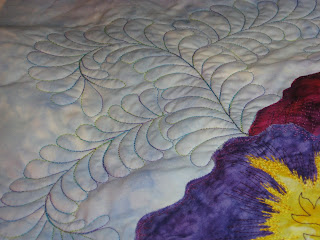There have been several requests on how I thread paint. I'm still a beginner and learning. You have an advantage--you can see my mistakes and avoid them.
Update: I've been working on more thread painting and decided to update this post.
I first trace my picture with a fine point pigma pen on water soluble stabilizer from
Superior Threads. When storing this stabilizer, I store it in an airtight container or plastic bag because our humidity is so high.
This time I used Aquamesh, which is a wash away embroidery stabilizer. This is just a little heavier and some people may like it better than the plastic type stabilizer.
I lightly sprayed basting spray on my fabric on the right side and placed my bird picture on top. I also used two sheets of tear-away stabilizer underneath my fabric. The basting spray was used very sparingly on the tear away.
This time I sprayed on the wrong side of my bird picture and laid it on my fabric.
I did use four quilting pins in the corners to make sure everything stayed in place. Forty weight machine embroidery thread was used for the top thread. The thread in the bobbin is a thinner thread that is made for machine embroidery. You can buy it on a spool or on prewound bobbins. I prefer using the bobbins that come with my machine and I think that the prewound bobbins are wound too tight for it to smoothly come off the bobbin. I had a few prewound bobbins that were given to me by a professional embroidery business that I rewound. Before I started coloring in my picture, I bring my bobbin thread up to the top.

Since I've been free motion quilting, I thought that I wouldn't put my fabric in a hoop. Study your picture of your bird and look for colors that are in your bird and start coloring your picture in. I used both a straight stitch and a very narrow zigzag depending on what look I wanted. When you use the zigzag please be careful that it's not too wide that your needle will hit your darning foot.
I used a little bit of blue to shade is his head. Once I shaded in his head, you hardly see the blue, but the highlights are still there. The secret is shading in with several different shades of thread. Really look hard at your picture to see what colors are on your bird. I use a back and forth motion to color in my bird. If you have never seen an embroidery machine sew out a picture, I would highly advise that you watch one in action. You will understand how thread painting works.
Thread is very expensive and there is no way I could afford these spools brand new. My secret is out--watch Ebay for a deal. I ran across someone that wanted to get rid of her extra machine embroidery thread. Shop around and know your prices. The two main brands of thread I used were Isacord and Madeira poly neon. I chose polyester over rayon because of strength. Rayon does look beautiful, but right now I'm just in the experimenting stage and I have plenty of thread to practice with.
After I'm done thread painting, I remove the water soluble stabilizer by tearing it away and misting a little water on spots that I can't get to.
There is a reason that people use hoops for their embroidery! When there is heavy stitching, the fabric draws up and puckers like. I did do some ironing and it helped out a lot. Just make sure that your iron isn't too hot because I think it could melt your polyester thread.
I removed the tear away being careful not to cut my fabric. I'm not sure if it was a good idea to use the basting glue--I thought it might stop the puckers! The basting glue worked so well that I was afraid that I might accidentally cut my fabric!
I do not have a picture of it, but I put two layers of Warm and Natural batting underneath my picture. Below I am sewing around my picture with invisible thread.
This time instead of using invisible thread I used Vanish thread. This thread is wash away! Please don't get it mixed in with your other thread or you could be in for a big surprise when your quilted item is washed!
I'm not sure if I like the invisible thread or the Vanish thread--I'm just experimenting.
Then I cut the excess of batting away. This is called machine trapunto, which I learn this technique from
Patsy Thompson. The main reason why I did this technique was to take up the fullness so I wouldn't have any puckers and it worked!
I sandwiched my quilt together with my favorite basting spray and a few safety pins. Now I'm ready to quilt!
As I experiment with this new adventure, I will let you know what I have learned.
I'm still learning!
I want to thank Vic Murayma letting me use a picture of his humming bird. Please check out his pictures of birds--they are absolutely amazing pictures!
Happy Quilting!
Kay Lynne










































































.jpg)








